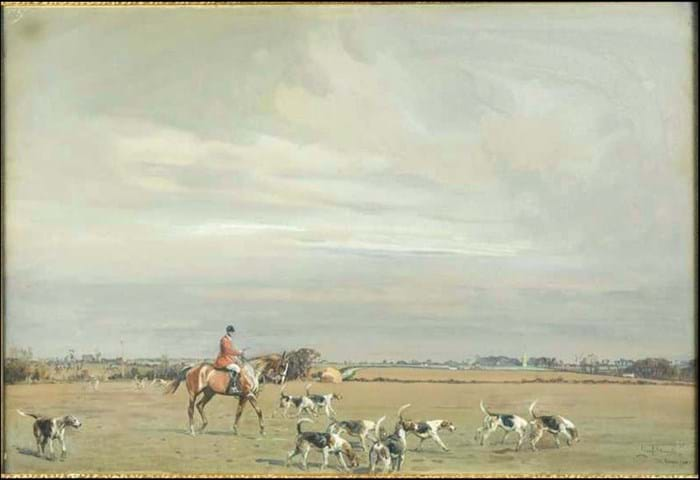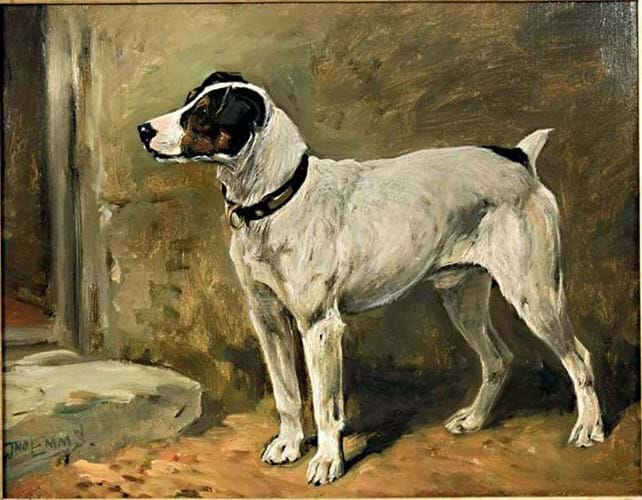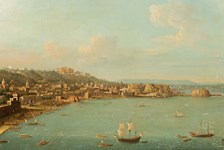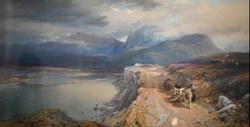
Lord Cleveland’s Voltaire beating Major Yarborough’s Laurel, catalogued as by John Frederick Herring Sr, £28,000 at Dore & Rees.
However, today the going is famously ‘soft’ to ‘heavy’ for 19th century images of the Turf.
When a John Frederick Herring Sr (1795-1865) painting of Doncaster racecourse emerged at Dore & Rees (25% buyer’s premium) in Frome on June 7, the estimate of £1500-2500 can scarcely have been more than the picture cost when it last sold at Christie’s in 1979.
The Somerset auction house said the estimate was based on a very old probate valuation rather than a reflection of any condition issues. It came for sale from a Wiltshire probate source.
Signed and dated 1829, the 20¾in x 2ft 9in (53 x 84cm) oil on canvas was titled Lord Cleveland’s Voltaire beating Major Yarborough’s Laurel. It belonged to a series of early racing pictures depicting the Doncaster Gold Cup, a hard-fought race over two miles and five furlongs.
The horses are shown passing the old neoclassical grandstand, painted here in meticulous detail. The previous year’s winner Laurel, bred by Major Nicholas Yarburgh of York, is beaten by more than a length by Voltaire, a two-year-old owned by William Henry Vane (1766-1842), 1st Marquess and later Duke of Cleveland.
Herring Sr spent his first 18 years in London but in 1814 moved to Doncaster. He found employment as a painter of inn signs and coach insignia and as a coach driver but the ‘artist coachman’ also picked up commissions to paint the hunters and racehorses of the local gentry.
In 1830, Herring left Doncaster for Newmarket where he spent three years before achieving fame and fortune in London as an animal painter to the royal family.
While Doncaster subjects remain among the most valuable subjects in Herring Sr’s oeuvre (the auction record of $1.8m/£1.13m came for a painting from 1825 showing of the start of the Doncaster Gold Cup that sold at Sotheby’s New York), this particular work was probably a collaboration between Herring and James Pollard (1792-1867).
The two artists often worked in tandem with Herring painting the race and horses while Pollard is thought to have depicted the grandstands and thronging crowds.
In Dorset it generated some respectable competition and, after a good biddling battle, was knocked down at £28,000.
Mixed fortunes
Meanwhile, three works by Lionel Edwards (1878-1966) experienced mixed interest at Cheffins (24.5% buyer’s premium) in Cambridge on June 28-29.
Two were works on paper that were commissioned by the poet and war veteran Captain John (Jack) Newman Gilbey, a lifetime friend of the artist and part of the family who founded the successful wine and spirits business Gilbey’s Gin Distillery. Here they were being sold by Captain Gilbey’s great-nephew.
Painted in March and April 1928 from near Colville Hall in Essex, one of the works titled The Essex depicted the Essex Hunt with White Roding village church in the background.
Signed and dated, the 20in x 2ft 6in (51 x 75cm) gouache had a lot going for it commercially, showing a broad view of the local landscape and at the same time demonstrating the artist’s considerable talent in painting animals and huntsmen in precise detail.
Estimated at £4000-6000, bidders duly responded and it was knocked down at £7500 – a decent sum for a work on paper by the artist in the current market.
The following lot was a smaller preparatory study of the landscape for The Essex, although here depicting the same rural location with snow on the ground. Lacking any horses or riders, a factor making the going much harder for any work by sporting specialist Edwards, it was unsold against a £2000-3000 estimate.
The fact that plenty of supply is available means Edwards’ buyers can afford to be selective, something also demonstrated when a separately consigned view of a huntsman and hounds traversing a field titled On the scent was also unsold against a £6000-8000 pitch. Having previously fetched £7000 at Sotheby’s in 2015, it also showed the importance of market freshness in this sector.
A study of a Jack Russell by leading dog painter John Emms (1844-1912) generated more interest at Cheffins.
While the artist’s larger studies of foxhounds are what tends to excite the market most (some have fetched six-figure prices at auction), this 12½ x 16in (32 x 41cm) signed oil on canvas was a characterful study that duly found admirers.
In good stable condition with no retouching visible under UV light, although with a thick layer of varnish to the surface, it overshot a £4000-6000 estimate and sold at £6500.
Only one higher price is recorded on Artprice for a portrait of a single Jack Russell by Emms: Nip: Study of a Jack Russell that made £7200 at Sotheby’s Billingshurst in 2000.

















